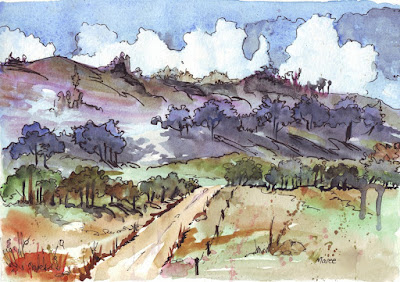Here in South Africa there aren't many choices of journals or sketch-books for artists to choose from in our book stores or art supply shops. I would imagine one of the few choices is the Moleskine range - they offer sketching and watercolour notebooks in various sizes, and they are really great to use - I have a full range - but that's about the extent of it. If you would like to make your own, personalised sketch-book, here's a really fun, quick and easy way to do it.
For this project I used an A4 Bockingford 300gsm watercolour pad (containing 10 sheets of paper) cut in half to form an A5 size (5.5" x 7.5" - approx. 14 x 19cm), giving me 20 pages. You can use any paper you like, but less than 140gsm doesn't give a good surface for painting on. You can also fold and tear the paper in stead of cutting it for an interesting effect on the edges, or use different colour papers.
For the front and back covers I used the backing card of the A4 watercolour pad (cut in half), but you can use any stiff board cut to size, even covers from old books.
The next step is to mark where you want your holes and punch the holes into your paper and stiff board covers. You can use ribbon to hold the book together like I have done here, or you can use binder rings found at most craft shops. Two should do the job. I used a leather hole punch to do 2 or 3 pages of paper together, as 300gsm is quite thick. Or you could use the standard office 2-hole punch with the holes in the centre of the paper, but I have found that top and bottom works best to keep the book stable.
I punched 6 holes into the pages of this journal as I was going to put it into a leather-bound ring binder I already have, but when the pages proved to be too big, and I didn't want to cut them smaller, I changed my mind and decided to use the ribbon.
And here's the enjoyable part - designing your front and back covers. I have used plain brown paper to cover the stiff boards and glued on some Hessian cut into an interesting shape, using ordinary Pritt Project glue (Ponal or Alcolin wood glue does the same job). You can, of course, use any pretty paper or gift wrap you have lying around as well.
Optionally, for the inside back cover, I cut a piece of Hessian, glued all along the top, right-hand side and bottom edges, leaving the uneven edge open, to form a pocket for some notes (money or other-wise!). Always comes in handy when you've been out sketching in the heat and you need to buy a cold drink.
Enjoy and happy sketching!
List of supplies :
- 10 Sheets A4 watercolour paper, cut in half
- 1 sheet A4 board, cut in half
- 2 binder rings or ribbon, string, cord of your choice,
- Office or leather hole punch
- Gift, wrapping or any paper to cover front and back covers
- Scissors
- Craft glue
























